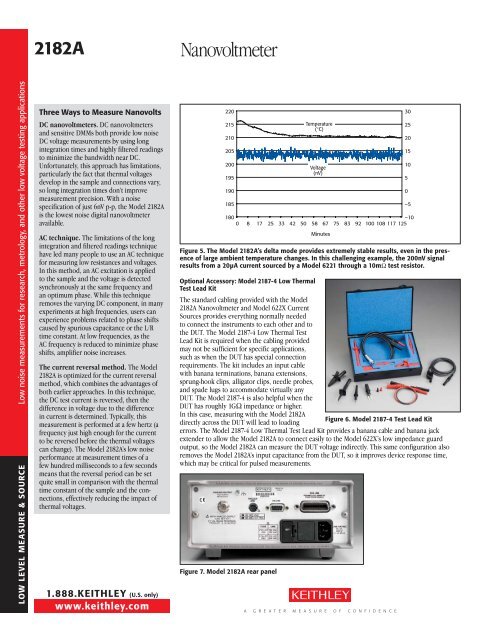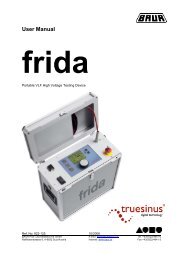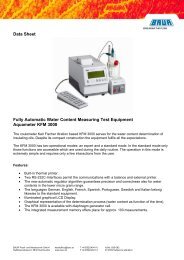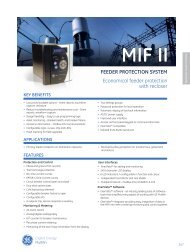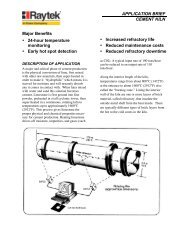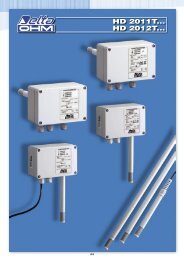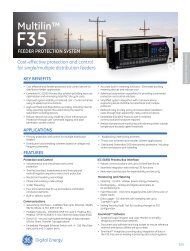Nanovoltmeter - Belmet
Nanovoltmeter - Belmet
Nanovoltmeter - Belmet
You also want an ePaper? Increase the reach of your titles
YUMPU automatically turns print PDFs into web optimized ePapers that Google loves.
2182A<br />
<strong>Nanovoltmeter</strong><br />
Low noise measurements for research, metrology, Side Text and other low voltage testing applications<br />
LOW LEVEL MEASURE & SOURCE<br />
Three Ways to Measure Nanovolts<br />
DC nanovoltmeters. DC nanovoltmeters<br />
and sensitive DMMs both provide low noise<br />
DC voltage measurements by using long<br />
integration times and highly filtered readings<br />
to minimize the bandwidth near DC.<br />
Unfortunately, this approach has limitations,<br />
particularly the fact that thermal voltages<br />
develop in the sample and connections vary,<br />
so long integration times don’t improve<br />
measurement precision. With a noise<br />
specification of just 6nV p-p, the Model 2182A<br />
is the lowest noise digital nanovolt meter<br />
available.<br />
AC technique. The limitations of the long<br />
integration and filtered readings technique<br />
have led many people to use an AC technique<br />
for measuring low resistances and voltages.<br />
In this method, an AC excitation is applied<br />
to the sample and the voltage is detected<br />
syn chronously at the same frequency and<br />
an optimum phase. While this technique<br />
removes the varying DC component, in many<br />
experiments at high frequencies, users can<br />
experience problems related to phase shifts<br />
caused by spurious capacitance or the L/R<br />
time constant. At low frequencies, as the<br />
AC frequency is reduced to minimize phase<br />
shifts, amplifier noise increases.<br />
The current reversal method. The Model<br />
2182A is optimized for the current reversal<br />
method, which combines the advantages of<br />
both earlier approaches. In this technique,<br />
the DC test current is reversed, then the<br />
difference in voltage due to the difference<br />
in current is determined. Typically, this<br />
measure ment is performed at a few hertz (a<br />
frequency just high enough for the current<br />
to be reversed before the thermal voltages<br />
can change). The Model 2182A’s low noise<br />
performance at measurement times of a<br />
few hundred milliseconds to a few seconds<br />
means that the reversal period can be set<br />
quite small in comparison with the thermal<br />
time constant of the sample and the connections,<br />
effectively reducing the impact of<br />
thermal voltages.<br />
1.888.KEITHLEY (U.S. only)<br />
www.keithley.com<br />
220<br />
215<br />
210<br />
205<br />
200<br />
195<br />
190<br />
185<br />
Temperature<br />
(°C)<br />
Voltage<br />
(nV)<br />
180<br />
–10<br />
0 8 17 25 33 42 50 58 67 75 83 92 100 108 117 125<br />
Minutes<br />
Figure 5. The Model 2182A’s delta mode provides extremely stable results, even in the presence<br />
of large ambient temperature changes. In this challenging example, the 200nV signal<br />
results from a 20µA current sourced by a Model 6221 through a 10mW test resistor.<br />
Optional Accessory: Model 2187-4 Low Thermal<br />
Test Lead Kit<br />
The standard cabling provided with the Model<br />
2182A Nano volt meter and Model 622X Current<br />
Sources provides everything normally needed<br />
to connect the instruments to each other and to<br />
the DUT. The Model 2187-4 Low Thermal Test<br />
Lead Kit is required when the cabling provided<br />
may not be sufficient for specific applications,<br />
such as when the DUT has special connection<br />
requirements. The kit includes an input cable<br />
with banana terminations, banana extensions,<br />
sprung-hook clips, alligator clips, needle probes,<br />
and spade lugs to accommodate virtually any<br />
DUT. The Model 2187-4 is also helpful when the<br />
DUT has roughly 1GW impedance or higher.<br />
In this case, measuring with the Model 2182A<br />
Figure 6. Model 2187-4 Test Lead Kit<br />
directly across the DUT will lead to loading<br />
errors. The Model 2187-4 Low Thermal Test Lead Kit provides a banana cable and banana jack<br />
extender to allow the Model 2182A to connect easily to the Model 622X’s low impedance guard<br />
output, so the Model 2182A can measure the DUT voltage indirectly. This same configuration also<br />
removes the Model 2182A’s input capacitance from the DUT, so it improves device response time,<br />
which may be critical for pulsed measurements.<br />
Figure 7. Model 2182A rear panel<br />
A G R E A T E R M E A S U R E O F C O N F I D E N C E<br />
30<br />
25<br />
20<br />
15<br />
10<br />
5<br />
0<br />
–5


